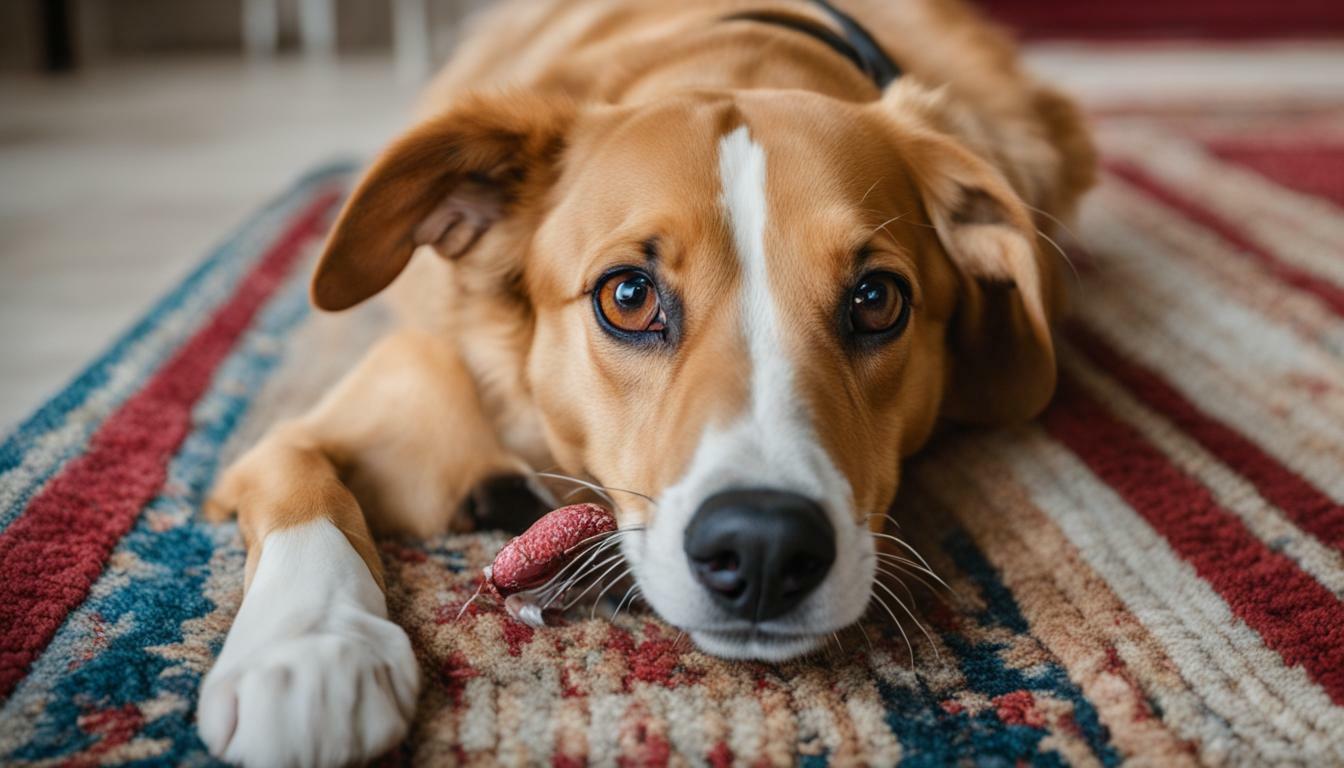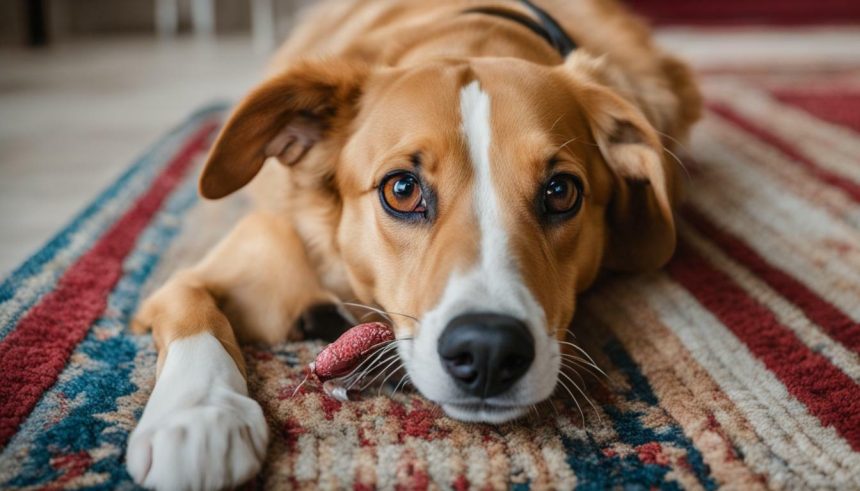Have you ever caught your furry friend licking the rug and wondered why they do it? As bizarre as it may seem, rug licking is a normal dog behavior and can be influenced by various factors. This article will discuss why dogs lick rugs, including their instincts, sensory exploration, behavioral causes, and potential medical conditions.
Key Takeaways:
- Rug licking is an expected behavior among dogs.
- Grasping the motives for this behavior can assist you in addressing possible issues.
- Dogs may lick rugs due to natural grooming instincts, sensory exploration, behavioral causes such as anxiety, or underlying medical conditions.
- Practical training and behavioral modification techniques can help redirect your dog’s attention away from rug-licking.
- If you have concerns about your pet’s rug-licking habits, consult a veterinarian or professional dog behaviorist for personalized guidance.
To understand how to make custom pet rugs, follow this link.

Canine Licking Behaviors
Before we dive into the specific reasons why dogs might lick rugs, we must understand the broader topic of canine licking behaviors. Dogs use their tongues as a means of communication, grooming, and exploration.
Licking is an automatic action for dogs with multiple interpretations. For instance, when dogs lick their humans, it might indicate love, submissiveness, or a plea for attention. Similarly, when dogs lick themselves, it’s usually for grooming purposes, such as keeping their fur clean and tangle-free.
However, some dogs exhibit excessive licking behaviors that can be problematic. Compulsive licking, for example, can be a sign of anxiety or stress, while excessive licking of objects such as rugs can indicate underlying medical conditions or behavioral issues.
It’s essential to observe your dog’s licking habits and determine whether they are within the normal range of behaviors. If you notice excessive or abnormal licking, it may be a sign that something is amiss and requires further investigation.
Natural Instincts and Grooming
Dogs have an instinct for grooming, which involves using their tongues to clean themselves. This behavior can be seen from a young age when puppies are licked by their mothers to clean and stimulate them.
As dogs grow, they continue to use their tongues to groom and maintain their hygiene. You may observe your furry friend licking themselves multiple times daily.
While licking themselves is common, dogs also display grooming behavior towards their owners and other dogs. This signifies affection and bonding as they express love and care for those around them.
Beyond self-grooming and showing affection, dogs may also exhibit grooming behavior towards objects, including rugs. This can be due to their innate instinct for cleaning and maintaining their environment.
It’s crucial to highlight that persistent rug licking might indicate deeper behavioral or health problems, which we’ll delve into in subsequent sections. However, in many cases, rug licking may result from your dog’s natural grooming behavior.
Sensory Exploration and Taste
One of the primary reasons dogs lick rugs is their sensory exploration instinct. Canines use their tongues to gather information about the world, including the taste and texture of surfaces such as rugs.
Dogs have taste receptors on their tongues that help them distinguish between different flavors, and by licking a rug, they can gather information about the materials it’s made of and any scents that may be present. This sensory exploration can be incredibly enticing for curious dogs with a strong sense of smell.
Although rug licking may seem quirky, it’s important to remember that it’s rooted in a dog’s instincts for survival and exploration.
Behavioral Causes and Anxiety
Has your dog been licking rugs incessantly? It might be a sign of anxiety or other behavioral issues.
Dogs are delicate beings who can quickly feel stressed or anxious for several reasons, including alterations in their surroundings or schedule, fear of separation, and aversion to loud sounds. Rug licking can serve as a coping mechanism for dogs to self-soothe in response to these stressors.
If you suspect that your dog’s rug licking is related to anxiety or other behavioral causes, there are steps you can take to help your furry friend. Providing a safe and secure environment, incorporating regular exercise and playtime into their routine, and practicing positive reinforcement training can all help reduce anxiety in dogs.
It’s also essential to consult with a professional dog behaviorist or trainer to determine the root cause of your dog’s behavior and develop effective strategies for addressing it.
Remember that rug licking can be a symptom of more significant underlying issues. Thus, it’s vital to consult with experts if your dog’s licking activity intensifies or if it’s paired with other indicators of discomfort.
Medical Conditions and Compulsions
If you have ruled out behavioral causes for your dog’s rug licking, an underlying medical issue may be at play. Compulsive licking can signify several medical conditions, including allergies, gastrointestinal problems, and neurological disorders.
Allergies can cause dogs to feel itchy and uncomfortable, leading them to seek relief by licking or chewing on their skin or objects such as rugs. Digestive problems, such as acid reflux or inflammatory bowel conditions, might lead to discomfort, prompting dogs to lick items like carpets. Neurological disorders, such as seizures or obsessive-compulsive disorder (OCD), can also trigger compulsive licking behaviors.
If you believe a medical condition is behind your dog’s carpet licking, seeking advice from a vet is essential. A comprehensive check-up can pinpoint potential health issues and guide the right treatment path.
Training and Behavioral Modification
If your dog’s rug-licking behavior is becoming a concern, there are various techniques you can use to modify their behavior. Training and behavioral modification can help redirect your dog’s attention away from rugs and onto other activities.
One method is to provide your dog with chew toys or bones to keep them occupied and satisfied. This can help alleviate anxiety or boredom that may be causing them to lick rugs excessively.
Another approach is to divert your dog’s focus to different tasks, like playing catch or taking a stroll. Consistently reinforcing positive behaviors with praise and rewards can encourage your dog to engage in those activities rather than licking rugs.
Should the behavior continue despite your attempts, it’s advisable to consult a professional dog trainer or behaviorist. They can pinpoint the core reason for the behavior and offer tailored solutions to alter it.
Remember, every dog is unique, and finding the proper training and behavioral modification techniques may require trial and error. However, you can help your furry friend overcome their rug-licking habit with patience and consistency.
Conclusion
In understanding canine behaviors, we encounter many interesting quirks, including the mysterious habit of dogs licking rugs. Through our exploration of this behavior, we have learned that dogs lick for various reasons ranging from instincts to behavioral and medical issues.
If your dog continuously licks your rugs, it could indicate an underlying problem. However, with proper training techniques and behavioral modification strategies, you can redirect your dog’s attention away from the rug and onto alternative behaviors.
Remember that every dog is different, and consulting a veterinarian or professional dog behaviorist is always the best option when you have concerns about your pet’s behavior.
In conclusion, understanding rug-licking mysteries is just one small part of the complex world of canine behavior. By striving to understand our furry friends’ behaviors, we can better care for them and build a stronger bond with them.
